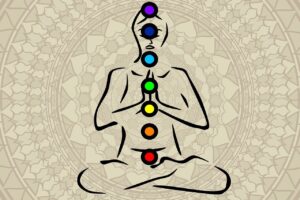We all experience times when we feel out of balance. There are numerous reasons for this, including lifestyle choices, seasonal changes, health issues, periods when we don’t prioritize our spiritual well-being, and other factors that can disrupt our lives. Yoga provides various tools to help us restore balance and align ourselves with God. One way yoga assists us in this process is by studying and balancing our chakras.
Chakras
Yoga philosophy discusses chakras as points within our body that regulate the flow of energy. They can be blocked, balanced, or too open. These chakras are believed to regulate various aspects of physical, emotional, and spiritual well-being.
I know sometimes, when Christians hear about energy, they turn off their brains or roll their eyes and put this in the category of weird yoga stuff. I’ve been there, too. But you don’t have to believe in its energy aspect to reap the benefits of assessing these areas of your body and life. Instead, consider it a tool to align yourself with scripture and promote physical and emotional health.
In most traditions, seven main chakras are aligned along the spine, from the base to the top of the head. Each chakra is associated with specific physical and psychological functions. When these energy centers are balanced, they are thought to promote health and harmony, whereas blockages or imbalances in the chakras can lead to physical ailments and emotional disturbances. Practicing yoga and meditation helps to balance and align the chakras to enhance overall well-being.
Christian Connection
Are there things in your life that you need to deal with that might prevent you from fully experiencing and feeling the presence of the Holy Spirit? Or maybe something is making you feel off or not quite like yourself, and you can’t quite put your finger on it? Perhaps there are actions, trauma, lies, or areas of unforgiveness that you need to process. We can begin to identify these things by looking at the Chakra system and then turning to God for direction, healing, or forgiveness.
If you look at the Greek root word for being filled with the Holy Spirit, plēroō, it has this connotation of continuously being filled. We receive the Holy Spirit when we accept and confess Jesus as our savior. But then there is the ongoing work of being filled with the Holy Spirit and living according to its guidance. Continually being filled to overflow is part of the process of sanctification.
Balancing our chakras, or if you want to look at it instead as balancing our spirit and emotions, is one way to ensure we are open to God and filled with the Holy Spirit. It’s an opportunity to access ourselves, ask for healing in any areas needing healing, and confess anything that needs forgiveness.
If you’re interested in reading about more yoga philosophy from a Christian Perspective, check out this article on the Eight Limbs of Yoga.
Similar Traditions
Various traditions have identified different energy systems in the body. These systems include Nadis, Aura, Meridians, Padmas, and Qi, each with varying numbers of energy centers and definitions. In the Western yoga tradition, the 7-Chakra system is the most commonly discussed, and it became the dominant system in the 15th century.
All of these systems have some similarities. They all point to centers in the lower belly, heart, and around the crown of the head. From what we can find in historical documents about the original intent in outlining the chakra system, the purpose was to chant specific sounds of the Sanskrit alphabet to bring attention to an area of the body, invite energy into the body, and promote healing.
Chakra Theory
Let’s take a brief look at the historical development of Chakra Theory.
Early Vedic Period
The concept of chakras is not explicitly mentioned in the earliest Vedic texts (1500-500 BC), but the foundational ideas of energy centers and channels can be traced back to the Vedas. The Rigveda and Atharvaveda reference prana (breath and vital life force) and nadis (energy channels), setting the stage for later developments.
Upanishadic Period
The Upanishads (circa 800-200 BC) are the earliest detailed descriptions of chakras. They describe the seven primary chakras, each associated with different aspects of human experience and consciousness.
Classical and Post-Classical Periods
The Tantras elaborate extensively on the chakra system. These texts provide detailed descriptions of the chakras, including their locations, symbols, colors, and mantras (words or sounds).
Classical yoga texts, such as the Yoga Sutras of Patanjali (circa 400 BC), don’t explicitly mention chakras but discuss the control and cultivation of prana (breath or life force), which is closely related. The Hatha Yoga Pradipika (15th century) and other Hatha yoga texts describe techniques to awaken and balance the chakras through practices like pranayama (breath control), asanas (postures), and mudras (hand gestures).
Modern Period
Chakras were introduced to the West in the 19th and 20th centuries. And like we usually do in the West, we adapted things to meet our needs and understanding of the world.
The modern Chakra system identifies each point with a significant endocrine gland and a major nerve plexus (bundles where nerves intersect). The energy of each chakra is thought to affect these glands and nerves and, therefore, the systems they control.
The historical development of the chakra system reflects a complex interplay of ancient spiritual traditions, philosophical ideas, and cultural exchanges, evolving over millennia to become what we know as the Chakra System today.
Today, the Chakra System is widely recognized in various holistic and alternative medicine practices. The system has been popularized globally, with numerous books, workshops, and courses dedicated to understanding and balancing the chakras.
A Christian perspective on chakras offers a unique approach to spiritual well-being and alignment with scripture. While the concept of chakras and energy centers may be unfamiliar or even controversial to some, it is clear that practicing yoga and understanding the Chakra System can be valuable tools for promoting physical, emotional, and spiritual health.
Exploring the connection between the chakras and the Christian faith can help us seek balance, healing, and a deeper connection with God. Embracing the principles of Chakra Theory within a Christian context provides an opportunity for self-reflection, healing, and a renewed sense of spiritual alignment.
Learn about the Root Chakra from a Christian perspective, including scriptures and activities to help promote balance, wellness, and alignment with God’s word.
Take a free Christian Yoga Class on my YouTube Channel!
Tonya is a 500hr RYT based in Coastal Mississippi. She loves that she gets to share the joy and healing that yoga brought to her life. In addition to teaching yoga, she flips houses with her husband. Tonya is a travel enthusiast who loves the outdoors and adventure. You'll find her at the local beach, volunteering at the animal shelter, and playing with her forever and foster dogs.






0 Comments